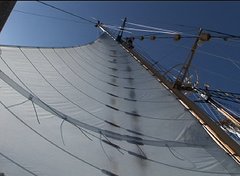Palmyra Atoll is paradise. Offshore
of Palmyra, wave crests break violently over the coral reef surrounding the
island. These corals protect Palmyra’s serene inner lagoon by dissipating the
furious energies of ocean waves and tides. This outer coral reef separates the
unforgiving cobalt sea from the tranquil turquoise waters welcoming those
entering the lagoon. Tall coconut trees loom out of the dense forest and cast
dancing flowery shadows over white sand. Entering Palmyra Atoll was truly
unforgettable.
Now what?
It turns out that science must press on and maintaining the ship doesn’t stop
when the anchor hits the sea floor. We are still organized in watch squads that
collectively are responsible for ship duties 24 hours of every day. Even in
paradise we remain “eternally vigilant” as Captain Pamela Coughlin constantly
urges us to do. We conduct half-hourly radar and anchor checks to make sure we
remain in a fixed location and we strive to keep the boat in top condition. As
assistant scientist Mitch Schrimpf says,”On the ship, cleanliness IS
godliness”. The crew of the boat stays busy repairing the boat, updating and
organizing nautical charts, and unloading the huge load of supplies we brought
to the Palmyra station (this makes me think our voyage is a glorified UPS
service). Our scientists toil away at the delicate chemistry involved in
processing phosphate and nitrate samples gathered from our hydrocasts. As students,
we are responsible for assisting our scientists and crew with these tasks on
top of helping our wonderful cook Sayzie in the galley with preparing food.
When not
occupied with watch though, we have some truly awesome opportunities to explore
Palmyra. Our crew operates small craft that take us on outings to land or
snorkeling spots each morning and afternoon. Some of us help out with other
student projects in the reef environment and some of us just go out for
recreation. People have told tales of the awesome megafauna spotted in the reef
including blacktip sharks, manta rays, and huge snappers (that if caught on rod
and reel would be all-tackle world records according to our resident IGFA
representative Martini. However The Nature Conservancy owns and protects
Palmyra so no sport or commercial fishing is allowed). Land expeditions have
also been thrilling and full of discovery. I went on one land expedition that
witnessed one of the most bizarre animal interactions I have ever seen.
Eels occupy
nooks in the shallow reef environment and are generally ambush predators. Eels
have small fins on a flexible undulating body, which aerodynamically and
physiologically limits their proficiency at hunting in open water. Instead,
eels coil up and blend in with the sand and coral and wait to devour
unsuspecting prey swimming by. Or so we thought.
The north
shore of Palmyra is as ideal as a postcard and is only marred by ruins left by
the U.S. naval base from World War II over which hordes of crabs now scuttle
frantically. Our land expedition was passing one of these old navy bunkers when
Nicole suddenly yelped and pointed at a 3-foot spotted moray eel slithering out
of the water and onto the beach snaking its way directly for her. However the
eel paid no mind to Nicole and instead lunged for an oblivious ghost crab
catching some sun and seized it between its jaws. The eel proceeded to tie
itself in a half hitch and used the torque to audibly crack the crab’s shell,
sealing its fate. The eel then widened its jaws and swallowed the crab whole
all on the white sand under the hot tropical sun. It then casually slithered
back over the sand into the shallows without even glancing at the four of us
documenting this remarkable event. Holy shit that was cool.


1 comment:
Walter, thanks for a great description of your time at Palmyra! Your family sends you and your shipmates lots of love!
Post a Comment